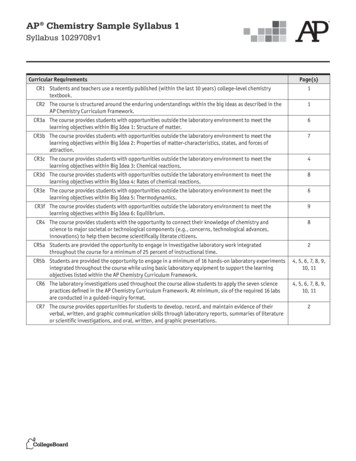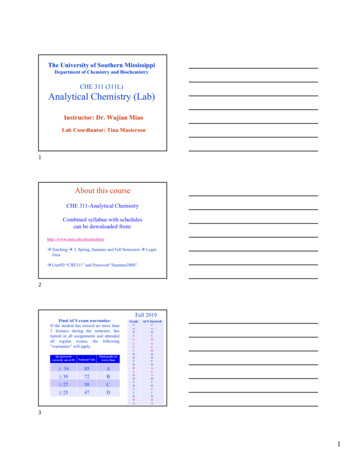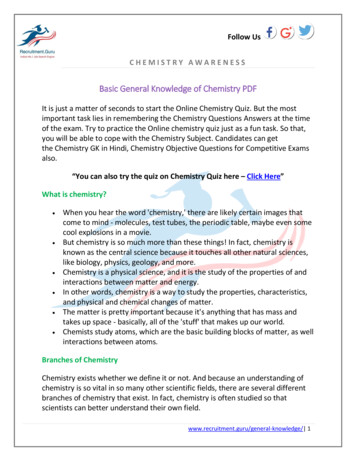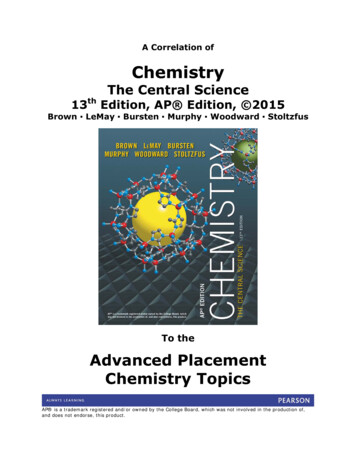
Transcription
AP Chemistry Sample Syllabus 1Syllabus 1029708v1Curricular RequirementsPage(s)CR1 Students and teachers use a recently published (within the last 10 years) college-level chemistrytextbook.1CR2 The course is structured around the enduring understandings within the big ideas as described in theAP Chemistry Curriculum Framework.1CR3a The course provides students with opportunities outside the laboratory environment to meet thelearning objectives within Big Idea 1: Structure of matter.6CR3b The course provides students with opportunities outside the laboratory environment to meet thelearning objectives within Big Idea 2: Properties of matter-characteristics, states, and forces ofattraction.7CR3c The course provides students with opportunities outside the laboratory environment to meet thelearning objectives within Big Idea 3: Chemical reactions.4CR3d The course provides students with opportunities outside the laboratory environment to meet thelearning objectives within Big Idea 4: Rates of chemical reactions.8CR3e The course provides students with opportunities outside the laboratory environment to meet thelearning objectives within Big Idea 5: Thermodynamics.6CR3f The course provides students with opportunities outside the laboratory environment to meet thelearning objectives within Big Idea 6: Equilibrium.9CR4 The course provides students with the opportunity to connect their knowledge of chemistry andscience to major societal or technological components (e.g., concerns, technological advances,innovations) to help them become scientifically literate citizens.8CR5a Students are provided the opportunity to engage in investigative laboratory work integratedthroughout the course for a minimum of 25 percent of instructional time.2CR5b Students are provided the opportunity to engage in a minimum of 16 hands-on laboratory experimentsintegrated throughout the course while using basic laboratory equipment to support the learningobjectives listed within the AP Chemistry Curriculum Framework.4, 5, 6, 7, 8, 9,10, 11CR6 The laboratory investigations used throughout the course allow students to apply the seven sciencepractices defined in the AP Chemistry Curriculum Framework. At minimum, six of the required 16 labsare conducted in a guided-inquiry format.4, 5, 6, 7, 8, 9,10, 11CR7 The course provides opportunities for students to develop, record, and maintain evidence of theirverbal, written, and graphic communication skills through laboratory reports, summaries of literatureor scientific investigations, and oral, written, and graphic presentations.2
AP Chemistry Sample Syllabus 1Syllabus 1029708v1Course DescriptionThis AP Chemistry course is designed to be the equivalent of the general chemistrycourse usually taken during the first year of college. For most students, the courseenables them to undertake, as a freshman, second year work in the chemistry sequenceat their institution or to register in courses in other fields where general chemistry isa prerequisite. This course is structured around the six big ideas articulated in the APChemistry curriculum framework provided by the College Board. [CR2] A special emphasiswill be placed on the seven science practices, which capture important aspects of thework that scientists engage in, with learning objectives that combine content withinquiry and reasoning skills. AP Chemistry is open to all students that have completeda year of chemistry who wish to take part in a rigorous and academically challengingcourse.CR2—The course isstructured around theenduring understandingswithin the big ideasas described in the APChemistry CurriculumFramework.Big Idea 1: Structure of matterBig Idea 2: Properties of matter-characteristics, states, and forces of attractionBig Idea 3: Chemical reactionsBig Idea 4: Rates of chemical reactionsBig Idea 5: ThermodynamicsBig Idea 6: EquilibriumTextbooks and Lab BooksThe College Board. AP Chemistry Guided Inquiry Experiments: Applying the SciencePractices. 2013.Zumdahl, Steven and Susan Zumdahl. Chemistry, Eighth Edition. Belmont CA: CengageLearning, 2012. [CR1]Demmin, Peter. AP Chemistry, Fifth Edition. New York: D&S Marketing Systems Inc.,2005.CR1—Students andteachers use a recentlypublished (within the last10 years) college-levelchemistry textbook.Vonderbrink, Sally. Laboratory Experiments for AP Chemistry. Batavia: Flinn Scientific,2001.Randall, Jack. Advanced Chemistry with Vernier. Oregon: Vernier Software andTechnology, 2004.Holmquist, Dan and Donald Volz. Chemistry with Calculators. Oregon: Vernier Softwareand Technology, 2003.Beran, Jo Allan. Laboratory Principles of General Chemistry, Seventh Edition. New York:John Wiley and Sons, 2004.Required MaterialsGraphing calculator, splash proof goggles, and a carbon capable laboratory notebookLabsThe labs completed require following or developing processes and procedures, takingobservations, and data manipulation. See lab list provided for lab details. Studentscommunicate and collaborate in lab groups; however, each student writes a laboratory1
AP Chemistry Sample Syllabus 1report in a lab notebook for every lab they perform. A minimum of 25% of student contacttime will be spent doing hands-on laboratory activities. [CR5a]The 10 Parts of a Laboratory Report [CR7]A specific format will be given to the student for each lab. Students must follow thatformat and label all sections very clearly. AP Chemistry lab reports are much longer andmore in depth than the ones completed in the first year chemistry course. Therefore, it isimportant that students don’t procrastinate when doing pre-lab and post-lab work. Latelabs will not be accepted. Labs not completed in class must be done at lunch or before/after school by appointment.Pre-Lab WorkPre-lab work is to be completed and turned in on the day the lab is performed.1. TitleThe title should be descriptive. For example, “pH Titration Lab” is a descriptive titleand “Experiment 5” is not a descriptive title.2. DateThis is the date the student performed the experiment.Syllabus 1029708v1CR5a—Students areprovided the opportunityto engage in investigativelaboratory work integratedthroughout the course fora minimum of 25 percent ofinstructional time.CR7—The course providesopportunities for studentsto develop, record, andmaintain evidence of theirverbal, written, and graphiccommunication skillsthrough laboratory reports,summaries of literature orscientific investigations,and oral, written, andgraphic presentations.3. PurposeA purpose is a statement summarizing the “point” of the lab.4. Procedure OutlineStudents need to write an outline of the procedure. They should use bulletedstatements or outline format to make it easy to read. If a student is doing a guidedinquiry lab, they may be required to write a full procedure that they develop.5. Pre-Lab QuestionsStudents will be given some questions to answer before the lab is done. They willneed to either rewrite the question or incorporate the question in the answer. Theidea here is that when someone (like a college professor) looks at a student’s labnotebook, they should be able to tell what the question was by merely looking attheir lab report. It is important to produce a good record of lab work.6. Data TablesStudents will need to create any data tables or charts necessary for data collection inthe lab.During the Lab7. DataStudents need to record all their data directly in their lab notebook. They are NOT tobe recording data on their separate lab sheet. They need to label all data clearly andalways include proper units of measurement. Students should underline, use capitalletters, or use any device they choose to help organize this section well. They shouldspace things out neatly and clearly.2
AP Chemistry Sample Syllabus 1Syllabus 1029708v1Post-Lab Work8. Calculations and GraphsStudents should show how calculations are carried out. Graphs need to be titled,axes need to be labeled, and units need to be shown on the axis. To receive credit forany graphs, they must be at least ½ page in size.9. ConclusionsThis will vary from lab to lab. Students will usually be given direction as to what towrite, but it is expected that all conclusions will be well thought out and well written.10. Post Lab Error Analysis QuestionsFollow the same procedure as for Pre-Lab Questions.Advanced Placement Chemistry — The Laboratory NotebookA record of lab work is an important document, which will show the quality of the lab workthat students have performed.AP Chemistry Unit OverviewUnit 1: Chemistry FundamentalsClass Periods (52 minutes): 12Homework Sets Assigned: 10Number of Quizzes: 2Number of Exams: 1Topics Covered:1. Scientific Method2. Classification of Mattera. pure substances vs mixturesb. law of definite proportionsc. law of multiple proportionsd. chemical and physical changes3. Nomenclature and formula of binarycompounds4. Polyatomic ions and other compounds5. Determination of atomic masses6. Mole concept7. Percent composition8. Empirical and molecular formula9. Writing chemical equations and drawnrepresentations10. Balancing chemical equationsCurriculum Framework Articulation:BI 1.D.1:a1.A.1:b1.A.1:c1.A.1:d3.C.1:b, 3.C.1:c, 5.D:21.E.2:b1.E.2:b1.A.1:a1.A.3:b, 1.A.3:c, 1.A.3:d, 1.E.2:b1.A.2:a1.A.2:b1.E.1:a, 1.E.1:c, 3.C.1:a1.A.3:a, 1.E.2:c, 1.E.2:d, 3.A.1:a3
AP Chemistry Sample Syllabus 111. Applying mole concept to chemicalequations (Stoich)12. Determine limiting reagent, theoretical and% yieldSyllabus 1029708v11.A.3:a, 1.E.1:b3.A.2:aLabs: [CR5b] & [CR6]Math & Measurement in ScienceLO 1.3; SP 2, 5*Guided Inquiry: Physical and Chemical Properties LO 1.17, 1.18; SP 1, 3, 4, 6Stoichiometry LabLO 1.1, 3.3, 3.4; SP 2, 5Unit 2: Types of Chemical EquationsClass Periods (52 minutes): 8Homework Sets Assigned: 4Number of Quizzes: 3Number of Exams: 1Topics Covered:1. Electrolytes and properties of water2. Molarity and preparation of solutions3. Precipitation reactions and solubility rules4. Acid Base reactions and formation of a saltby titration5. Balancing redox6. Simple redox titrations7. Gravimetric calculationsLabs: [CR5b] & [CR6]pH Titration LabBleach LabActivity: Online Redox Titration Activityprovided the opportunityto engage in a minimumof 16 hands-on laboratoryexperiments integratedthroughout the coursewhile using basic laboratoryequipment to support thelearning objectives listedwithin the AP ChemistryCurriculum Framework.CR6—The laboratoryCurriculum Framework Articulation:2.A.3:h1.D.3:c, 2.A.3:i, 2.A.3:j6.C.3:d1.E.2:f, 3.A.2:c3.B.3:a, 3.B.3:b, 3.B.3:c, 3.B.3:d1.E.2:f1.E.2:eLO 1.2; SP 2, 5LO 1.18, 3.8, 3.9; SP 2, 5LO 3.9; SP 1Utilizing an eduweb lab simulation, students have the opportunity to manipulate variousfactors that influence a redox titration. [CR3c]Unit 3: AP Style Net Ionic EquationsClass Periods (52 minutes): 8Homework Sets Assigned: 6Number of Quizzes: 4Number of Exams: 1Topics Covered:1. Redox and single replacement reactions2. Double replacement reactions3. Combustion reactionsCR5b—Students areinvestigations usedthroughout the courseallow students to apply theseven science practicesdefined in the AP ChemistryCurriculum Framework.At minimum, six of therequired 16 labs areconducted in a guidedinquiry format.CR3c—The course providesstudents with opportunitiesoutside the laboratoryenvironment to meet thelearning objectives withinBig Idea 3: Chemicalreactions.Curriculum Framework Articulation:3.A.1, 3.B.3:e, 3.C.1:d3.A.1, 3.C.1:d3.A.1, 3.B.3:e4
AP Chemistry Sample Syllabus 14. Addition reactions5. Decomposition reactionsLabs: [CR5b] & [CR6]Copper Reactions LabUnit 4: Gas LawsClass Periods (52 minutes): 8Homework Sets Assigned: 5Number of Quizzes: 3Number of Exams: 1Topics Covered:1. Measurement of gases2. General gas laws - Boyle, Charles, Combined,and Ideal3. Dalton’s Law of partial pressure4. Molar volume of gases and Stoichiometry5. Graham’s Law6. Kinetic Molecular Theory7. Real Gases and deviation from ideal gas law8. Graham’s Law demonstrationLabs: [CR5b] & [CR6]Molecular Mass of a Volatile LiquidUnit 5: ThermochemistryClass Periods (52 minutes): 8Homework Sets Assigned: 5Number of Quizzes: 3Number of Exams: 1Topics Covered:1. Law of conservation of energy, work, andinternal energy2. Endothermic and exothermic reactions3. Potential energy diagrams4. Calorimetry, heat capacity, and specific heat5. Hess’s law6. Heat of formation/combustion7. Bond energiesSyllabus 1029708v13.A.1, 3.B.1:a3.A.1, 3.B.1:a, 3.C.1:dLO 1.4, 3.1, 3.2, 3.5, 3.6, 3.10; SP 6Curriculum Framework Articulation:2.A.2:a, 2.A.2:c2.A.2:b3.A.2:b2.A.2:d, 5.A.12.A.2:e, 2.A.2:f, 2.A.2:g, 2.B.2:c,2.B.2:dLO 2.6; SP 1, 6CR5b—Students areprovided the opportunityto engage in a minimumof 16 hands-on laboratoryexperiments integratedthroughout the coursewhile using basic laboratoryequipment to support thelearning objectives listedwithin the AP ChemistryCurriculum Framework.CR6—The laboratoryinvestigations usedthroughout the courseallow students to apply theseven science practicesdefined in the AP ChemistryCurriculum Framework.At minimum, six of therequired 16 labs areconducted in a guidedinquiry format.LO 2.4, 2.5, 5.2; SP 2, 5Curriculum Framework Articulation:5.B.1, 5.E.2:a3.C.2, 5.B.3:e, 5.B.3:f3.C.2, 5.C.2:c, 5.C.2:d, 5.C.2:e5.A.2, 5.B.2, 5.B.3:a, 5.B.3:b, 5.B.45.B.3:a5.C.2:g2.C.1:d, 5.C.1, 5.C.2:a, 5.C.2:b5
AP Chemistry Sample Syllabus 1Labs: [CR5b] & [CR6]*Guided Inquiry: Hess’s Law LabActivity: Online Heating and Cooling CurveSimulationsSyllabus 1029708v1LO 3.11, 5.3-5.5, 5.7, 5.8; SP 2, 5, 3,4, 6LO 5.6 & SP 1Utilizing the eduweb lab simulation website, students heat an unknown and graph itstemperature as it cools, giving them the ability to calculate the energy released. [CR3e]Unit 6: Atomic Structure and PeriodicityClass Periods (52 minutes): 12Homework Sets Assigned: 9Number of Quizzes: 4Number of Exams: 1Topics Covered:1. Electron configuration and the Aufbauprinciple2. Valence electrons and Lewis dot structures3. Periodic trends4. Table arrangement based on electronicproperties5. Properties of light and study of waves6. Atomic spectra of hydrogen and energylevels7. Quantum mechanical model8. Quantum theory and electron orbitals9. Orbital shape and energies10. SpectroscopyLabs: [CR5b] & [CR6]Spectroscopy LabActivity: Periodic Table Dry LabCR3e—The courseprovides students withopportunities outside thelaboratory environmentto meet the learningobjectives within Big Idea5: Thermodynamics.CR5b—Students areCurriculum Framework Articulation:1.B.2:a1.B.2:c1.B.1:b, 1.B.1:c, 1.B.2:b, 1.B.2:d,1.C.1:c, 1.D.1:b, 2.C.1:a, 2.C.1:b1.C.1:a, 1.C.1:b, 1.C.1:d1.C.2:e, 1.D.3:a, 5.E.4:b1.B.1:d, 1.B.1:e, 1.D.3:b1.C.2:d1.C.2:c1.C.2:b1.D.2:a, 1.D.2:b, 1.D.2:c, 1.D.3:bLO 1.5, 1.6, 1.7, 1.8, 1.14, 1.15; SP1, 6LO 1.9, 1.10, 1.11, 1.12, 1.13; SP 1,5, 6Students graph values for atomic radius, electronegativity, and ionization energy topredict trends and explain the organization of the periodic table. [CR3a]provided the opportunityto engage in a minimumof 16 hands-on laboratoryexperiments integratedthroughout the coursewhile using basic laboratoryequipment to support thelearning objectives listedwithin the AP ChemistryCurriculum Framework.CR6—The laboratoryinvestigations usedthroughout the courseallow students to apply theseven science practicesdefined in the AP ChemistryCurriculum Framework.At minimum, six of therequired 16 labs areconducted in a guidedinquiry format.CR3a—The course providesstudents with opportunitiesoutside the laboratoryenvironment to meet thelearning objectives withinBig Idea 1: Structure ofmatter.6
AP Chemistry Sample Syllabus 1Unit 7: Chemical BondingClass Periods (52 minutes): 11Homework Sets Assigned: 8Number of Quizzes: 4Number of Exams: 1Topics Covered:1. Lewis Dot structures2. Resonance structures and formal charge3. Bond polarity and dipole moments4. VSEPR models and molecular shape5. Polarity of molecules6. Lattice energies7. Hybridization8. Molecular orbitals and diagramsLabs: [CR5b] & [CR6]*Guided Inquiry: Bonding Lab*Guided Inquiry: Investigation of SolidsActivity: Atomic Theory Dry LabSyllabus 1029708v1CR5b—Students areCurriculum Framework Articulation:2.C.4:a2.C.4:c, 2.C.4:d, 2.C.4:e2.C.1:c, 2.C.1:e, 2.C.1:f2.C.4:b, 2.C.4:e, 2.C.4:f2.C.1:e1.B.1:a, 1.C.2:a, 2.C.1:d (1-2),2.C.2:a, 2.C.2:b, 2.D.1:b2.C.4:g2.C.4:h, 2.C.4:iLO 2.1, 2.17, 2.19, 2.20, 5.1, 5.10; SP1, 3, 4LO 2.22-2.32; SP 1, 3, 4, 6LO 2.21 & SP 1, 6Students make drawings of a series of molecules and from those drawings predictgeometry, hybridization, and polarity. [CR3b]Unit 8: Liquids, Solids, and SolutionsClass Periods (52 minutes): 6Homework Sets Assigned: 4Number of Quizzes: 2Number of Exams: 1Topics Covered:1. Structure and bondinga. metals, network, and molecularb. ionic, hydrogen, London, van der Waals2.3.4.5.Vapor pressure and changes in stateHeating and cooling curvesComposition of solutionsColloids and suspensionsprovided the opportunityto engage in a minimumof 16 hands-on laboratoryexperiments integratedthroughout the coursewhile using basic laboratoryequipment to support thelearning objectives listedwithin the AP ChemistryCurriculum Framework.CR6—The laboratoryinvestigations usedthroughout the courseallow students to apply theseven science practicesdefined in the AP ChemistryCurriculum Framework.At minimum, six of therequired 16 labs areconducted in a guidedinquiry format.CR3b—The course providesstudents with opportunitiesoutside the laboratoryenvironment to meet thelearning objectives withinBig Idea 2: Properties ofmatter-characteristics,states, and forces ofattraction.Curriculum Framework Articulation:2.A.1:a, 2.A.1:d, 2.C.3, 2.D.1:a,2.D.2:a, 2.D.1:b, 2.D.3, 2.D.42.A.1:b, 2.B.1:a, 2.B.1:b, 2.B.1:c,2.B.2:a, 2.B.2:b, 2.B.2:c, 2.B.2:d,2.B.3:a, 5.D:12.A.1:e, 5.B.3:c, 5.B.3:d2.A.1:c, 2.A.3:b, 2.A.3:c, 2.B.3:b2.A.3:a, 2.A.3:b, 2.A.3:g7
AP Chemistry Sample Syllabus 1Syllabus 1029708v16. Separation techniques7. Effect on biological systemsTeacher Lab Demo: Evaporation of liquids2.A.3:e, 2.A.3:f2.B.3:e, 2.D.3, 5.E.4:cLO 2.11, 2.18, 5.9, 5.12; SP 1, 6Labs: [CR5b] & [CR6]Solution Preparation LabVapor Pressure of Liquids LabLO 2.8, LO 2.9, 2.14, 2.15; SP 1-4LO 2.3, 2.12, 2.13, 2.16; SP 2, 5, 6Activity: Effect on biological systems [CR4]Students examine a demonstration size model of DNA or an alpha helix, and use theirfingers to identify which atoms / base pairs are particularly involved in hydrogen bondingwithin the molecule, causing the helical structure. Students then discuss how theincreased UV light because of ozone depletion can cause chemical reactions and thusmutations and disruption of hydrogen bonding.Unit 9: KineticsClass Periods (52 minutes): 9Homework Sets Assigned: 3Number of Quizzes: 3Number of Exams: 1Topics Covered:1. Rates of reactions2. Factors that effect rates of reactions/collision theory3. Reaction Pathways4. Rate equation determinationa. rate constantsb. mechanismsc. method of initial ratesd. integrated rate laws5. Activation energy and BoltzmanndistributionTeacher Demo: Factors that Effect Rates ofReactionCurriculum Framework Articulation:4.A.1:a4.A.1:b, 4.A.1:c, 4.D.1, 4.D.24.B.3:a, 4.B.3:b4.A.2:a4.A.34.B.1, 4.C.1, 4.C.2, 4.C.34.A.2:c4.A.2:b, 4.A.3:d4.B.2, 4.B.3:cLO 4.1, 4.8, 4.9; SP 1Labs: [CR5b] & [CR6]*Guided Inquiry: Determining Order of a Reaction LO 1.16, 4.2, 4.3, 4.4; SP 2-6Determining the Activation Energy of a ReactionLO 4.5, 4.6; SP 2, 5Activity: Online Kinetics ActivityLO 4.1; SP 1, 3, 6CR4—The course providesstudents with theopportunity to connecttheir knowledge ofchemistry and scienceto major societal ortechnological components(e.g., concerns,technological advances,innovations) to help thembecome scientificallyliterate citizens.CR5b—Students areprovided the opportunityto engage in a minimumof 16 hands-on laboratoryexperiments integratedthroughout the coursewhile using basic laboratoryequipment to support thelearning objectives listedwithin the AP ChemistryCurriculum Framework.CR6—The laboratoryinvestigations usedthroughout the courseallow students to apply theseven science practicesdefined in the AP ChemistryCurriculum Framework.At minimum, six of therequired 16 labs areconducted in a guidedinquiry format.CR3d—The course providesstudents with opportunitiesoutside the laboratoryenvironment to meetthe learning objectiveswithin Big Idea 4: Rates ofchemical reactions.Using a web based simulation, students will study the elementary steps of a mechanismand how it relates to reaction rate and collision theory. [CR3d]8
AP Chemistry Sample Syllabus 1Unit 10: General EquilibriumClass Periods (52 minutes): 6Homework Sets Assigned: 4Number of Quizzes: 3Number of Exams: 1Topics Covered:1. Characteristics and conditions of chemicalequilibrium2. Equilibrium expression derived from rates3. Factors that affect equilibrium4. Le Chatlier’s principle5. The equilibrium constant6. Solving equilibrium problemsLabs: [CR5b] & [CR6]Determination of a Kc with Varied InitialConcentrationsActivity: Online Gas Phase Equilibrium ActivitySyllabus 1029708v1Curriculum Framework Articulation:6.A.1, 6.A.3:a, 6.A.3:f6.A.3:b6.A.3:c6.A.3:b, 6.B.1, 6.B.2, 6.C.3:e,6.C.3:f6.A.3:d, 6.A.3.e, 6.A.46.A.2LO 5.17, 6.1-6.10; SP 2, 5LO 6.8, 6.9; SP 1, 6In the online inquiry activity, students are able to manipulate the environment andproduce stresses that verify the tendency of Le Chatelier’s principle. [CR3f]Unit 11: Acids and BasesClass Periods (52 minutes): 8Homework Sets Assigned: 4Number of Quizzes: 3Number of Exams: 1Topics Covered:1. Definition and nature of acids and bases2.3.4.5.6.Kw and the pH scalepH of strong and weak acids and basesPolyprotic acidspH of saltsStructure of Acids and BasesLabs: [CR5b] & [CR6]Determination of a Ka by Half TitrationCurriculum Framework Articulation:3.B.2, 6.C.1:c, 6.C.1:d, 6.C.1:e,6.C.1:f6.C.1:a, 6.C.1:b, 6.C.1:g6.C.1:h6.C.1:nCR5b—Students areprovided the opportunityto engage in a minimumof 16 hands-on laboratoryexperiments integratedthroughout the coursewhile using basic laboratoryequipment to support thelearning objectives listedwithin the AP ChemistryCurriculum Framework.CR6—The laboratoryinvestigations usedthroughout the courseallow students to apply theseven science practicesdefined in the AP ChemistryCurriculum Framework.At minimum, six of therequired 16 labs areconducted in a guidedinquiry format.CR3f— The course providesstudents with opportunitiesoutside the laboratoryenvironment to meet thelearning objectives withinBig Idea 6: Equilibrium.LO 2.2, 3.7; SP 2, 59
AP Chemistry Sample Syllabus 1Unit 12: Buffers, Ksp, and TitrationsClass Periods (52 minutes): 11Homework Sets Assigned: 6Number of Quizzes: 4Number of Exams: 1Topics Covered:1. Characteristics and capacity of buffers2. Titrations and pH curves3. Choosing Acid Base Indicators4. pH and solubility5. Ksp Calculations and Solubility ProductLabs: [CR5b] & [CR6]Types of Titrations*Guided Inquiry: Preparation of a BufferMolar Solubility and Determination of KspUnit 13: ThermodynamicsClass Periods (52 minutes): 10Homework Sets Assigned: 5Number of Quizzes: 3Number of Exams: 1Topics Covered:1. Laws of thermodynamics2. Spontaneous process and entropy3. Spontaneity, enthalpy, and free energy4. Free energy5. Free energy and equilibrium6. Rate and SpontaneityLabs: [CR5b] & [CR6]Solubility and Determination of ΔH , ΔS , ΔG ofCalcium HydroxideSyllabus 1029708v1CR5b—Students areCurriculum Framework Articulation:6.C.26.C.1:i, 6.C.1:j, 6.C.1:k, 6.C.1:l,6.C.1:m6.C.3:a, 6.C.3:bLO 6.11, 6.12, 6.13, 6.14, 6.15, 6.16,6.17; SP 2, 5, 6LO 6.18, 6.19, 6.20; SP 2, 3, 4, 5LO 6.21, 6.22, 6.23, 6.24; SP 2, 5, 6provided the opportunityto engage in a minimumof 16 hands-on laboratoryexperiments integratedthroughout the coursewhile using basic laboratoryequipment to support thelearning objectives listedwithin the AP ChemistryCurriculum Framework.CR6—The laboratoryinvestigations usedthroughout the courseallow students to apply theseven science practicesdefined in the AP ChemistryCurriculum Framework.At minimum, six of therequired 16 labs areconducted in a guidedinquiry format.Curriculum Framework Articulation:5.E.15.E.2:c, 5.E.3,5.E.2:d, 5.E.2:e, 5.E.2:f, 6.C.3:c,6.D.1:a5.E.2, 6.D.1:b, 6.D.1:c, 6.D.1:d5.E.2:e, 5.E.5LO 5.12, 5.13, 5.14, 5.18, 6.25; SP2, 5, 610
AP Chemistry Sample Syllabus 1Unit 14: ElectrochemistryClass Periods (52 minutes): 8Homework Sets Assigned: 5Number of Quizzes: 4Number of Exams: 1Topics Covered:1. Balancing redox equations2. Electrochemical cells and voltage3. The Nernst equation4. Spontaneous and non-spontaneousequations5. Chemical applicationsTeacher Demo: Lead Storage BatteryDemonstrationLabs: [CR5b] & [CR6]Voltaic Cell LabAP ReviewClass Periods (52 minutes): Approximately 16Homework Sets Assigned: 0Number of Quizzes: 4Number of Exams: 4Topics Covered:Review of ALL topics4 AP Style Review ExamsMock APLabs: [CR5b] & [CR6]The Green Crystal LabSyllabus 1029708v1CR5b—Students areCurriculum Framework Articulation:3.B.3:a, 3.B.3:b, 3.B.3:c, 3.B.3:d3.C.3:a, 3.C.3:b, 3.C.3:c, 5.E.4:a3.C.3:d3.C.3:e3.C.3:fLO 3.12, 3.13, 5.15; SP 1LO 3.12, 3.13, 5.16; SP 2, 5provided the opportunityto engage in a minimumof 16 hands-on laboratoryexperiments integratedthroughout the coursewhile using basic laboratoryequipment to support thelearning objectives listedwithin the AP ChemistryCurriculum Framework.CR6—The laboratoryinvestigations usedthroughout the courseallow students to apply theseven science practicesdefined in the AP ChemistryCurriculum Framework.At minimum, six of therequired 16 labs areconducted in a guidedinquiry format.Curriculum Framework Articulation:1.A.2:cLO 1.2, 2.7, 2.10, 3.7, 3.8, 3.9, 5.11;SP 2, 5, 6AP Chemistry Lab ListThe following labs will be completed during the school year. Guided Inquiry Labs areindicated with an asterisk (*).Lab: Math and Measurement in Science & Density of an Organic LiquidDescription: Students learn how to measure mass and volume with varied pieces ofequipment and focus on the accuracy of those pieces of equipment in their calculationand determination of significant figures. Students also determine the identity of anunknown organic liquid using density determination.11
AP Chemistry Sample Syllabus 1Syllabus 1029708v1*GUIDED INQUIRY Lab: Discovery of Physical and Chemical PropertiesDescription: Students are given the materials to conduct various procedures. Theyconstruct a procedure for each of the eight changes to be observed, have their proceduresapproved by the instructor, and then carry out the procedures. The data collected isused to develop a set of criteria for determining whether a given change is chemical orphysical.Lab: Stoichiometry LabDescription: Students determine the correct mole ratio of reactants in an exothermicreaction by mixing different amounts of reactants and graphing temperature changes.Lab: pH Titration LabDescription: Students perform a titration and then determine the concentration of anHCl solution by using a potentiometric titration curve and finding the equivalence point.Data is graphed in a graphing program.Lab: Bleach LabDescription: Students perform redox titrations to determine the concentration ofhypochlorite in household bleach.Lab: Copper Reaction LabDescription: Students perform a series of reactions, starting with copper and endingwith copper. Students then calculate percent recovered.TEACHER DEMO: Graham’s Law of DiffusionDescription: HCl and NH3 are placed in either end of a glass tube. Using distancetraveled of each gas by looking at formation of NH4Cl ring, MM of HCl is calculated.Lab: Molar Mass of a Volatile LiquidDescription: Students use the Dumas method for determination of the molar mass of anunknown volatile liquid.Lab: Hess’s Law LabDescription: Students perform a series of reactions and calculate enthalpy, provingHess’s law.Lab: Spectrum and Spectroscopy LabDescription: Students look at a series of emission spectra and determine the identity ofan unknown. They will also receive and analyze IR and mass spectroscopy data.12
AP Chemistry Sample Syllabus 1Syllabus 1029708v1*GUIDED INQUIRY Lab: Bonding LabDescription: Students experimentally investigate ionic and molecular substancesdeducing properties of their bonds in the process.*GUIDED INQUIRY Lab: Investigation of SolidsDescription: Students investigate types of solids using various experimental techniques.Lab: Preparation of Solutions LabDescription: Students make solutions of specified concentrations gravimetricallyand by dilution. Solution concentrations will be checked for accuracy using aspectrophotometer.TEACHER DEMO: Evaporation of LiquidsDescription: Using a data collection device, the teacher will show the temperaturecurves of evaporation of various liquids and students must deduce the differences basedon IMF’s.Lab: Vapor Pressure of LiquidsDescription: Students measure the vapor pressure of ethanol at different temperaturesto determine H.*GUIDED INQUIRY Lab: Determining the Rate Law of a Crystal Violet ReactionDescription: Using colorimetry and Beer’s law, students determine the order of areaction and it’s rate law.Lab: Determining the Activation Energy of the Crystal Violet ReactionDescription: Students use the same set up as in the crystal violet lab, but this timevarying temperature to calculate the activation energy with the use of the Arrheniusequation.Lab: Determining Kc with Various Initial ConcentrationsDescription: Students use a spectrophotometer to determine the Kc of a series ofreactions.Lab: Determining Ka by Half TitrationDescription: Students do a titration in which ½ of the weak acid titrated is neutralized(aka midpoint) and then the Ka is determined.*GUIDED INQUIRY Lab: Types of TitrationsDescription: Students investigate titration curves by doing titrations of differentcombinations of weak and strong acids and bases.13
AP Chemistry Sample Syllabus 1Syllabus 1029708v1*GUIDED INQUIRY Lab: Preparation of a BufferDescription: Given a selection of chemicals, students prepare a buffer of a given p
AP Chemistry Sample Syllabus 1 Syllabus 1029708v1 Curricular Requirements Page(s) CR1 Students and teachers use a recently published (within the last 10 years) college-level chemistry textbook. 1 CR2 The course is structured around the enduring understandings within the big ideas as described in










